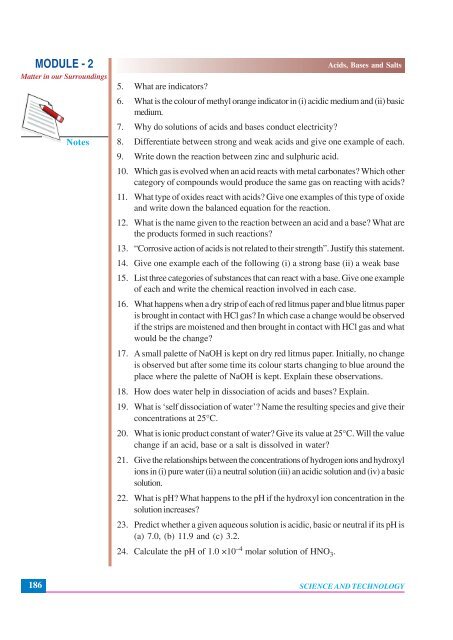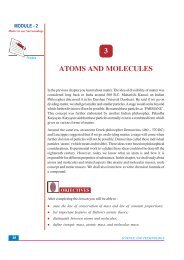8. Acids, Bases and Salts (41.1 MB)
8. Acids, Bases and Salts (41.1 MB)
8. Acids, Bases and Salts (41.1 MB)
You also want an ePaper? Increase the reach of your titles
YUMPU automatically turns print PDFs into web optimized ePapers that Google loves.
MODULE - 2<br />
Matter in our Surroundings<br />
Notes<br />
<strong>Acids</strong>, <strong>Bases</strong> <strong>and</strong> <strong>Salts</strong><br />
5. What are indicators?<br />
6. What is the colour of methyl orange indicator in (i) acidic medium <strong>and</strong> (ii) basic<br />
medium.<br />
7. Why do solutions of acids <strong>and</strong> bases conduct electricity?<br />
<strong>8.</strong> Differentiate between strong <strong>and</strong> weak acids <strong>and</strong> give one example of each.<br />
9. Write down the reaction between zinc <strong>and</strong> sulphuric acid.<br />
10. Which gas is evolved when an acid reacts with metal carbonates? Which other<br />
category of compounds would produce the same gas on reacting with acids?<br />
11. What type of oxides react with acids? Give one examples of this type of oxide<br />
<strong>and</strong> write down the balanced equation for the reaction.<br />
12. What is the name given to the reaction between an acid <strong>and</strong> a base? What are<br />
the products formed in such reactions?<br />
13. “Corrosive action of acids is not related to their strength”. Justify this statement.<br />
14. Give one example each of the following (i) a strong base (ii) a weak base<br />
15. List three categories of substances that can react with a base. Give one example<br />
of each <strong>and</strong> write the chemical reaction involved in each case.<br />
16. What happens when a dry strip of each of red litmus paper <strong>and</strong> blue litmus paper<br />
is brought in contact with HCl gas? In which case a change would be observed<br />
if the strips are moistened <strong>and</strong> then brought in contact with HCl gas <strong>and</strong> what<br />
would be the change?<br />
17. A small palette of NaOH is kept on dry red litmus paper. Initially, no change<br />
is observed but after some time its colour starts changing to blue around the<br />
place where the palette of NaOH is kept. Explain these observations.<br />
1<strong>8.</strong> How does water help in dissociation of acids <strong>and</strong> bases? Explain.<br />
19. What is ‘self dissociation of water’? Name the resulting species <strong>and</strong> give their<br />
concentrations at 25°C.<br />
20. What is ionic product constant of water? Give its value at 25°C. Will the value<br />
change if an acid, base or a salt is dissolved in water?<br />
21. Give the relationships between the concentrations of hydrogen ions <strong>and</strong> hydroxyl<br />
ions in (i) pure water (ii) a neutral solution (iii) an acidic solution <strong>and</strong> (iv) a basic<br />
solution.<br />
22. What is pH? What happens to the pH if the hydroxyl ion concentration in the<br />
solution increases?<br />
23. Predict whether a given aqueous solution is acidic, basic or neutral if its pH is<br />
(a) 7.0, (b) 11.9 <strong>and</strong> (c) 3.2.<br />
24. Calculate the pH of 1.0 ×10 –4 molar solution of HNO 3 .<br />
186<br />
SCIENCE AND TECHNOLOGY
















